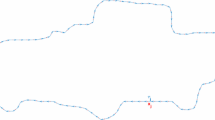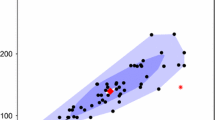Abstract
This paper focuses on the application of supervised classification techniques to a set of geometrical objects (bodies) characterized by currents, in particular, discriminant analysis and some nonparametric methods. A current is a relevant mathematical object to model geometrical data, like hypersurfaces, through integration of vector fields over them. As a consequence of the choice of a vector-valued reproducing kernel Hilbert space (RKHS) as a test space to integrate over hypersurfaces, it is possible to consider that hypersurfaces are embedded in this Hilbert space. This embedding enables us to consider classification algorithms of geometrical objects. We present a method to apply supervised classification techniques in the obtained vector-valued RKHS. This method is based on the eigenfunction decomposition of the kernel. The novelty of this paper is therefore the reformulation of a size and shape supervised classification problem in functional data analysis terms using the theory of currents and vector-valued RKHSs. This approach is applied to a 3D database obtained from an anthropometric survey of the Spanish child population with a potential application to online sales of children’s wear.




Similar content being viewed by others
References
Alonso AM, Casado D, Romo J (2012) Supervised classification for functional data: a weighted distance approach. Comput Stat Data Anal 56(7):2334–2346
Aneiros G, Bongiorno EG, Cao R, Vieu P et al (2017) Functional statistics and related fields. Springer, Berlin
Araki Y, Konishi S, Kawano S, Matsui H (2009) Functional logistic discrimination via regularized basis expansions. Commun Stat Theory Methods 38(16–17):2944–2957
Aronszajn N (1950) Theory of reproducing kernels. Trans Am Math Soc 68(3):337–404
Ballester A, Valero M, Nácher B, Piérola A, Piqueras P, Sancho M, Gargallo G, González J, Alemany S (2015) 3D body databases of the spanish population and its application to the apparel industry. In: Proceedings of the 6th international conference on 3D body scanning technologies, Lugano, Switzerland
Ballester A, Parrilla E, Piérola A, Uriel J, Pérez C, Piqueras P, Vivas J, Alemany S (2016) Data-driven three-dimensional reconstruction of human bodies using a mobile phone app. Int J Digit Hum 1(4):361–388
Barahona S, Gual-Arnau X, Ibáñez M, Simó A (2018) Unsupervised classification of children’s bodies using currents. Adv Data Anal Classif 12(2):365–397
Berlinet A, Thomas-Agnan C (2011) Reproducing kernel Hilbert spaces in probability and statistics. Springer, Berlin
Berrendero JR, Cuevas A, Torrecilla JL (2018) On the use of reproducing kernel hilbert spaces in functional classification. J Am Stat Assoc 113(523):1210–1218
Bickel PJ, Li B, Tsybakov AB, van de Geer SA, Yu B, Valdés T, Rivero C, Fan J, van der Vaart A (2006) Regularization in statistics. Test 15(2):271–344
Boj E, Caballé A, Delicado P, Esteve A, Fortiana J (2016) Global and local distance-based generalized linear models. Test 25(1):170–195
Bouveyron C, Brunet-Saumard C (2014) Model-based clustering of high-dimensional data: a review. Comput Stat Data Anal 71:52–78
Chiou JM, Li PL (2007) Functional clustering and identifying substructures of longitudinal data. J R Stat Soc Ser B (Stat Methodol) 69(4):679–699
Cuadras C (1989) Distance analysis in discrimination and classification using both continuous and categorical variables. Statistical data analysis and inference. Elsevier, Amsterdam, pp 459–473
Cucker F, Smale S (2001) On the mathematical foundations of learning. Am Math Soc 39(1):1–49
Cuesta-Albertos JA, Fraiman R (2007) Impartial trimmed k-means for functional data. Comput Stat Data Anal 51(10):4864–4877
Cuevas A (2014) A partial overview of the theory of statistics with functional data. J Stat Plan Inference 147:1–23
Cuevas A, Febrero M, Fraiman R (2007) Robust estimation and classification for functional data via projection-based depth notions. Comput Stat 22(3):481–496
Dai X, Müller HG et al (2018) Principal component analysis for functional data on riemannian manifolds and spheres. Ann Stat 46(6B):3334–3361
Delicado P (2007) Functional k-sample problem when data are density functions. Comput Stat 22(3):391–410
Delicado P (2011) Dimensionality reduction when data are density functions. Comput Stat Data Anal 55(1):401–420
Delicado P, Vieu P (2017) Choosing the most relevant level sets for depicting a sample of densities. Comput Stat 32(3):1083–1113
Devarajan P, Istook CL (2004) Validation of female figure identification technique (FFIT) for apparel software. J Text Appar Technol Manag 4(1):1–23
Di Marzio M, Fensore S, Panzera A, Taylor CC (2019) Kernel density classification for spherical data. Stat Probab Lett 144:23–29
Dryden IL, Mardia KV (2016) Statistical shape analysis: with applications. Wiley, Hoboken
Durrleman S (2010) Statistical models of currents for measuring the variability of anatomical curves, surfaces and their evolution. Ph.D. thesis, Université Nice Sophia Antipolis
Durrleman S, Pennec X, Trouvé A, Ayache N (2009) Statistical models of sets of curves and surfaces based on currents. Med Image Anal 13(5):793–808
Eubank R, Hsing T (2008) Canonical correlation for stochastic processes. Stoch Process Their Appl 118(9):1634–1661
Federer H, Fleming W (1960) Normal and integral currents. Ann Math 72:458–520
Ferraty F, Vieu P (2006) Nonparametric functional data analysis: theory and practice. Springer, Berlin
Fisher R (1936) The use of multiple measurements in taxonomic problems. Ann Eugen 7(2):179–188
Flores M, Gual-Arnau X, Ibáñez M, Simó A (2016) Intrinsic sample mean in the space of planar shapes. Pattern Recognit 60:164–176
Fraiman R, Gamboa F, Moreno L (2019) Connecting pairwise geodesic spheres by depth: DCOPS. J Multivar Anal 169:81–94
Garcia-Escudero LA, Gordaliza A (2005) A proposal for robust curve clustering. J Classif 22(2):185–201
Gerber S, Tasdizen T, Whitaker R (2009) Dimensionality reduction and principal surfaces via kernel map manifolds. In: IEEE 12th international conference on computer vision, IEEE, pp 529–536
Glaunès J, Joshi S (2006) Template estimation form unlabeled point set data and surfaces for computational anatomy. In: 1st MICCAI Workshop on mathematical foundations of computational anatomy: geometrical, statistical and registration methods for modeling biological shape variability
Goia A, Vieu P (2016) An introduction to recent advances in high/infinite dimensional statistics. J Multivar Anal 146:1–6
González J, Muñoz A (2010) Representing functional data in reproducing kernel hilbert spaces with applications to clustering and classification. Tech. rep., Universidad Carlos III de Madrid. Departamento de Estadística
Hall P, Poskitt D, Presnell B (2001) A functional data-analytic approach to signal discrimination. Technometrics 43(1):1–9
Horváth L, Kokoszka P (2012) Inference for functional data with applications, vol 200. Springer, Berlin
Hsing T, Eubank R (2015) Theoretical foundations of functional data analysis, with an introduction to linear operators. Wiley, Hoboken
Jacques J, Preda C (2014) Functional data clustering: a survey. Adv Data Anal Classif 8(3):231–255
James G, Hastie T (2001) Functional linear discriminant analysis for irregularly sampled curves. J R Stat Soc Ser B (Stat Methodol) 63(3):533–550
Kadri H, Duflos E, Preux P, Canu S, Rakotomamonjy A, Audiffren J (2016) Operator-valued kernels for learning from functional response data. J Mach Learn Res 17(1):613–666
Kendall D, Barden D, Carne T, Le H (2009) Shape and shape theory, vol 500. Wiley, Hoboken
Kent JT, Mardia KV, Morris RJ, Aykroyd RG (2001) Functional models of growth for landmark data. In: Proceedings in functional and spatial data analysis university of leeds, pp 109–115
Kneip A, Utikal KJ (2001) Inference for density families using functional principal component analysis. J Am Stat Assoc 96(454):519–542
Kupresanin A, Shin H, King D, Eubank R (2010) An rkhs framework for functional data analysis. J Stat Plan Inference 140(12):3627–3637
Lian H (2007) Nonlinear functional models for functional responses in reproducing kernel hilbert spaces. Can J Stat 35(4):597–606
Lin L, St Thomas B, Zhu H, Dunson DB (2017) Extrinsic local regression on manifold-valued data. J Am Stat Assoc 112(519):1261–1273
López-Pintado S, Romo J (2009) On the concept of depth for functional data. J Am Stat Assoc 104(486):718–734
Loubes JM, Pelletier B (2008) A kernel-based classifier on a riemannian manifold. Stat Decis Int Math J Stoch Methods Models 26(1):35–51
Lukić M, Beder J (2001) Stochastic processes with sample paths in reproducing kernel hilbert spaces. Trans Am Math Soc 353(10):3945–3969
Marron JS, Alonso AM (2014) Overview of object oriented data analysis. Biom J 56(5):732–753
MATLAB (2015) version 8.6.0 (R2015b). The MathWorks Inc., Natick, MA
Meunier P (2000) Use of body shape information in clothing size selection. In: Proceedings of the human factors and ergonomics society annual meeting. SAGE Publications Sage CA: Los Angeles, vol 44, pp 715–718
Müller HG (2005) Functional modelling and classification of longitudinal data. Scand J Stat 32(2):223–240
Pelletier B (2006) Non-parametric regression estimation on closed Riemannian manifolds. J Nonparametric Stat 18(1):57–67
Peng J, Müller HG et al (2008) Distance-based clustering of sparsely observed stochastic processes, with applications to online auctions. Ann Appl Stat 2(3):1056–1077
Pennec X (2006) Intrinsic statistics on Riemannian manifolds: basic tools for geometric measurements. J Math Imaging Vis 25(1):127–154
Preda C (2007) Regression models for functional data by reproducing kernel hilbert spaces methods. J Stat Plan Inference 137(3):829–840
Preda C, Saporta G, Lévéder C (2007) PLS classification of functional data. Comput Stat 22(2):223–235
Quang M, Kang S, Le T (2010) Image and video colorization using vector-valued reproducing kernel Hilbert spaces. J Math Imaging Vis 37(1):49–65
R Core Team (2018) R: A language and environment for statistical computing. R Foundation for Statistical Computing, Vienna, Austria. https://www.R-project.org/
Rham Gd (1960) Variétés différentiables. Formes, courants, formes harmoniques. Hermann et Cie, Butterworths Scientific Publications, Hermann
Ripley B (2007) Pattern recognition and neural networks. Cambridge University Press, Cambridge
Rossi F, Villa N (2008) Recent advances in the use of svm for functional data classification. Functional and operatorial statistics. Springer, Berlin, pp 273–280
Saitoh S, Sawano Y (2016) Theory of reproducing kernels and applications. Springer, Berlin
Schölkopf B, Smola AJ, Bach F et al (2002) Learning with kernels: support vector machines, regularization, optimization, and beyond. MIT Press, Cambridge
Senkene E, Tempel’man A (1973) Hilbert spaces of operator-valued functions. Math Trans Acad Sci Lith SSR 13(4):665–670
Serra J (1982) Image analysis and mathematical morphology. Academic Press, Cambridge
Shin H (2008) An extension of Fisher’s discriminant analysis for stochastic processes. J Multivar Anal 99(6):1191–1216
Silverman B, Ramsay J (2005) Functional data analysis. Springer, Berlin
Smale S, Zhou DX (2009) Geometry on probability spaces. Constr Approx 30(3):311–323
Stoyan D, Stoyan H (1994) Fractals, random shapes and point fields. Methods of geometrical statistics. Wiley, Hoboken
Tenenbaum JB, De Silva V, Langford JC (2000) A global geometric framework for nonlinear dimensionality reduction. Science 290(5500):2319–2323
Turaga PK, Srivastava A (2016) Riemannian computing in computer vision. Springer, Berlin
Vaillant M, Glaunès J (2005) Surface matching via currents. Information processing in medical imaging. Springer, Berlin, pp 381–392
Viktor HL, Paquet E, Guo H (2006) Measuring to fit: virtual tailoring through cluster analysis and classification. In: European conference on principles of data mining and knowledge discovery. Springer, Berlin, pp 395–406
Vinué G, Simó A, Alemany S (2016) The k-means algorithm for 3D shapes with an application to apparel design. Adv Data Anal Classif 10(1):103–132
Wang H, Marron J et al (2007) Object oriented data analysis: sets of trees. Ann Stat 35(5):1849–1873
Wang JL, Chiou JM, Müller HG (2016) Functional data analysis. Ann Rev Stat Its Appl 3:257–295
Younes L (1998) Computable elastic distance between shapes. SIAM J Appl Math 58(2):565–586
Acknowledgements
This paper has been partially supported by Projects DPI2017-87333-R and UJI-B2017-13. We would also like to thank the Biomechanics Institute of Valencia for providing us with the data set.
Author information
Authors and Affiliations
Corresponding author
Additional information
Publisher's Note
Springer Nature remains neutral with regard to jurisdictional claims in published maps and institutional affiliations.
Rights and permissions
About this article
Cite this article
Barahona, S., Centella, P., Gual-Arnau, X. et al. Supervised classification of geometrical objects by integrating currents and functional data analysis. TEST 29, 637–660 (2020). https://doi.org/10.1007/s11749-019-00669-z
Received:
Accepted:
Published:
Issue Date:
DOI: https://doi.org/10.1007/s11749-019-00669-z
Keywords
- Currents
- Statistical shape and size analysis
- Reproducing kernel Hilbert space
- Functional data analysis
- Supervised classification methods
- Discriminant analysis




